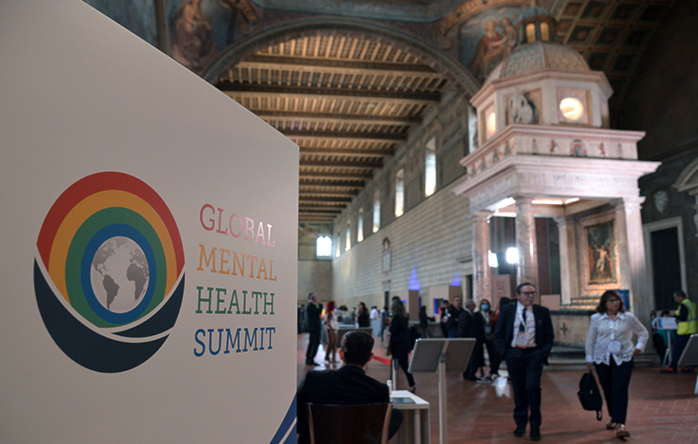
Recognising the importance of event location to overall meeting design, we chose a venue of immense symbolic significance. The monumental complex of Santo Spirito in Sassia is of great artistic and cultural – a hospital that dates back to the Middle Ages and is still operational today, having recently been renovated and reopened. Now that we are back to in-person meetings, it is more important than ever to leverage destination, location and face-to-face interaction to inspire participants, personalise projects and create really memorable events. We achieved this by finding a venue whose historic role linked closely to the congress theme, creating a connection between the delegates and the host destination, with its rich history in the field of mental health.
The exciting but unusual choice of venue involved a number of challenges. A former ward of the historic hospital had to be transformed into a state of the art meeting room, suitable for a ministerial summit. The IT set-up needs were complex – in order to guarantee the event’s technological functionality, the wi-fi had to be upgraded and the entire location wired with ad hoc lines to boost electricity, guarantee cybersecurity, and avoid overloading the hospital infrastructure. Whilst the event was mainly in person, a hybrid element was incorporated to allow remote speakers to deliver live content and delegates who were unable to reach Rome to attend the meeting virtually.
Moreover, a safety and security plan and checklist for the location had to be drawn up in collaboration with the traffic police, Police Headquarters and the Ministry of the Interior. Defined arrival routes were put in place for the guests, and the rest of the area then closed to traffic for safety reasons and manned by the police
The most important challenge posed by this high-level summit was the need to create the ceremonial protocol and secure logistical structure necessary to welcome and honour Ministers, institutions, authorities and representatives of Italian and international associations.
The event was attended by 52 delegations from different countries and international organizations. It was broadcast live, with simultaneous translation in English, French, Italian and international sign language.
The first morning was dedicated to an institutional plenary meeting, which was also broadcast live in a dedicated separate auditorium, reserved, for example, for embassy representatives.
The opening session included speeches from, amongst others, Italian Minister of Health Roberto Speranza, Ukrainian first lady, Olena Zelenska, connected by video-link, and the Director General of the World Health Organisation, Tedros Adhanom Ghebreyesus and Stella Kyriakides, EU Commissioner for Health, who both sent recorded video messages. There was unanimous consensus fact that “there is no health without mental health” and that mental health must be a global priority.
In the afternoon delegates divided into groups for thematic discussion in 4 parallel break-out rooms, then met at the end of the day for a recap. The Welcome Get Together was hosted in the hospital’s ancient cloister, quiet and discreet, but enlivened by the music of a string quartet.
The second day opened with reports of the thematic sessions and short addresses from each of 50 delegations. Throughout the event, a room was made available for private bilateral meetings between two countries, set up and dismantled with flags etc. for each meeting.
At the end of the Summit, the Italian Minister of Health, Roberto Speranza, passed the baton to Carla Vizzotti, Minister of Health of Argentina, the host country of GMHS 2023.
The event met all expectations: ceremonial protocol, timing, location, participant flow, technological infrastructure – everything worked seamlessly to support the mission of the conference, while the connection with a beautiful, historic place of care and healing inspired the delegates and enriched their memories.
Over 400 in-person participants and 50 online delegates, representing 52 accredited countries, worked together effectively, finding the plenary and four parallel rooms of one of the oldest hospitals in Europe the ideal venue to confront, discuss and share their objectives.

